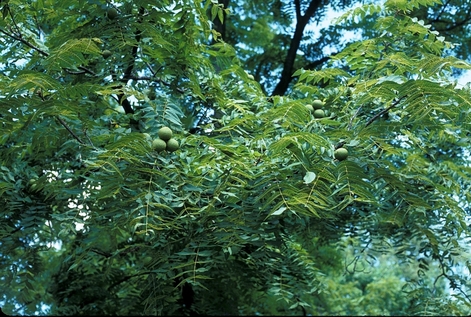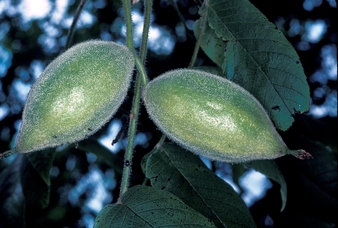Nut trees

A number of edible nuts occur in the lands around Onondaga Lake. Eaten either raw or mixed with other foods, nuts were used extensively by native people and later by EuroAmericans. Nutritional value of common northeastern nut trees is listed in Table 1. Most species (so-called “mast” trees) did not produce nuts with equal abundance every year, so people probably had to be opportunistic and collect from different species from year to year.
Parker (1968) points out the importance of nuts to the “Iroquois” diet:
"Great quantities were consumed during the nut season and quantities were stored for winter use. The nut season to the Iroquois was one of the happiest periods of the year especially for the young people to whom fell the work of gathering most of the nuts. The women however often went in companies when serious business was meant for with the failure of other crops, nuts formed an important food source. The nut season was called o’wadadwisaho."
Parker (1968) points out the importance of nuts to the “Iroquois” diet:
"Great quantities were consumed during the nut season and quantities were stored for winter use. The nut season to the Iroquois was one of the happiest periods of the year especially for the young people to whom fell the work of gathering most of the nuts. The women however often went in companies when serious business was meant for with the failure of other crops, nuts formed an important food source. The nut season was called o’wadadwisaho."

Hickories, walnut, butternut, chestnut, hazelnut, beech, and acorns were among the tree nuts eaten by Haudenosaunee people (Waugh 1916, Parker 1968). Oaks with the most edible acorns include swamp white oak and white oak, although red and chestnut oak were also used (Waugh 1916). People crushed the nutmeats of hickory, walnut, butternut and chestnut and mixed them with cornmeal for bread, or blended them into hominy or corn soup. Hickory, walnut, and other nuts were pounded, boiled in water, and the oil skimmed off and later added to bread, potatoes, pumpkin, squash. Moravian visitors to Onondaga in 1752 describe being “entertained” with “nut oil and salt” (Beauchamp et al. 1916); during an earlier journey, they refreshed themselves with “nut milk.”
Those seeking “nut milk” today will probably travel to Wegman’s and purchase almond or hazelnut milk in an aseptic box, the nuts grown on the west coast 2,000 miles away.
Women and children collected the nuts from the forest floor after the first frost. It is estimated that 1 acre of hardwood forest could supply XX calories, so support XX people. Maize, in fact, was likely first cultivated to supplement nut production in erratic years, before later becoming a staple itself.
Nut trees figure prominently into some place names. Morgan gives O-nan-no-gi-is-ska, as the Onondaga name for shagbark hickory (Carya ovata), as well as place names for what is now called “Cortland” and the Tioughnioga River (Morgan 1851). He gives O-nan-o-gese, “Long Hickory” (perhaps meaning tall) for Apulia. Another source, Baptist Thomas, gave the name as O-nea-no-ka-res-geh, “hickory grove” (Beauchamp 1923 p. 74).
According to Morgan, an early place name for Marcellus and Ninemile Creek was Us-te-ka, referring to bitternut hickory (Carya cordiformis) (Morgan 1851 p. 471). In “Onondaga Plant Names,” Beauchamp again gives the name of bitternut hickory as us’teek, and says it is the source of the place name Otisco (Beauchamp 1903?).
Table 2. Calorie, lipid, and protein content of nuts used by Indians of eastern US (adapted from Abrams and Nowacki 2008).
Those seeking “nut milk” today will probably travel to Wegman’s and purchase almond or hazelnut milk in an aseptic box, the nuts grown on the west coast 2,000 miles away.
Women and children collected the nuts from the forest floor after the first frost. It is estimated that 1 acre of hardwood forest could supply XX calories, so support XX people. Maize, in fact, was likely first cultivated to supplement nut production in erratic years, before later becoming a staple itself.
Nut trees figure prominently into some place names. Morgan gives O-nan-no-gi-is-ska, as the Onondaga name for shagbark hickory (Carya ovata), as well as place names for what is now called “Cortland” and the Tioughnioga River (Morgan 1851). He gives O-nan-o-gese, “Long Hickory” (perhaps meaning tall) for Apulia. Another source, Baptist Thomas, gave the name as O-nea-no-ka-res-geh, “hickory grove” (Beauchamp 1923 p. 74).
According to Morgan, an early place name for Marcellus and Ninemile Creek was Us-te-ka, referring to bitternut hickory (Carya cordiformis) (Morgan 1851 p. 471). In “Onondaga Plant Names,” Beauchamp again gives the name of bitternut hickory as us’teek, and says it is the source of the place name Otisco (Beauchamp 1903?).
Table 2. Calorie, lipid, and protein content of nuts used by Indians of eastern US (adapted from Abrams and Nowacki 2008).
